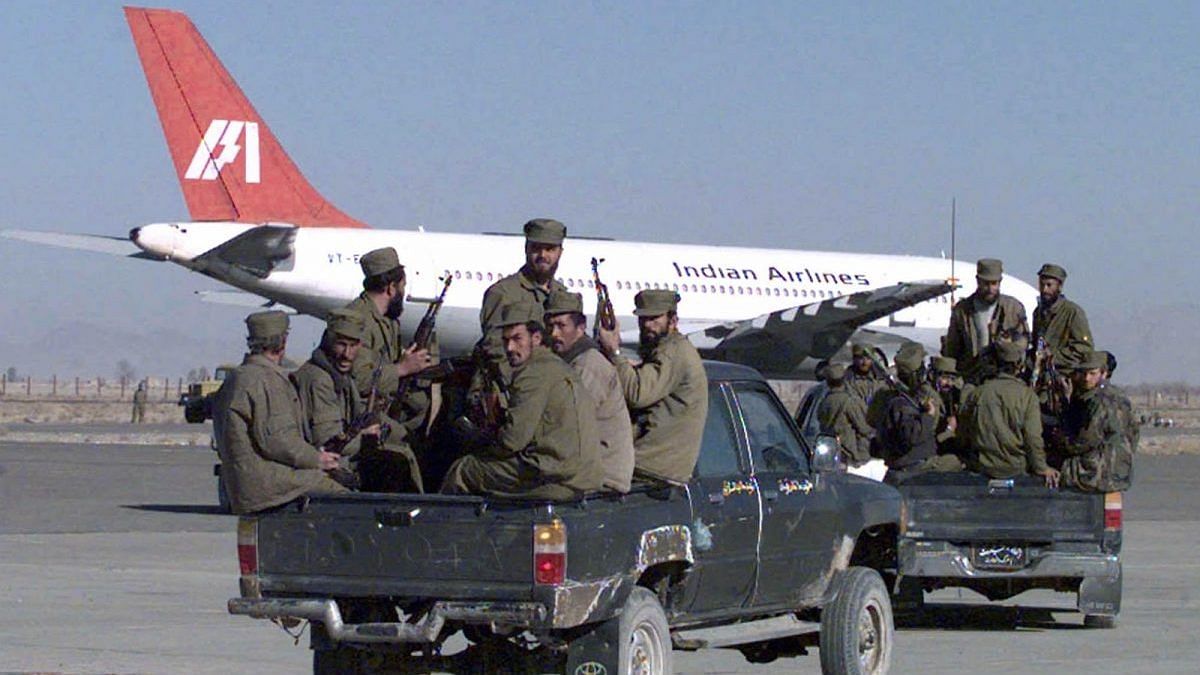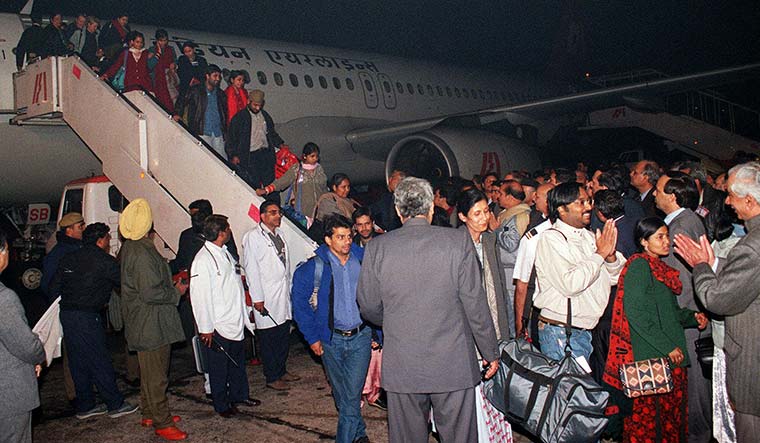On December 24, 1999, 25 years ago, Indian Airlines Flight IC-814, traveling from Kathmandu, Nepal, to New Delhi, became the focal point of a major global crisis when it was hijacked and eventually flown to Kandahar, Afghanistan
The hijacking of this aircraft, carrying 176 passengers and 15 crew members, remains one of the most notorious terrorist incidents in India’s history.
The incident not only drew global attention to the vulnerabilities in India’s aviation security stemming from neighboring countries but also resulted in a significant diplomatic and security demand from India: the transfer of security control at Tribhuvan International Airport in Kathmandu, Nepal, to Indian agencies.
The Hijacking Unfolds
On December 24, 1999, Flight IC-814, an Airbus 300, took off as planned from Kathmandu at around 4 pm. By 4:39 PM, as the plane reached Indian airspace, the situation turned grim.
Steward Anil Sharma was leaving the cockpit when an intruder, armed with a grenade and a revolver, forced his way in. This masked individual, whose face was hidden under a red balaclava, alarmed the crew with his menacing presence.
He declared that the aircraft had been hijacked, issuing a stern warning against any resistance. At 4:53 PM, four of his other masked companions took full control of the plane.
The hijackers, with their faces concealed and weapons in hand, demanded that Captain Devi Sharan divert the flight to Lahore, Pakistan, instead of New Delhi.
However, due to insufficient fuel for such a journey, the aircraft was first directed to land in Amritsar, India. There, Indian authorities prepared for a possible intervention. However, the hijackers, sensing potential threats, forced the plane to leave after a brief 47-minute stop without refueling.

Upon arriving in Lahore, the situation became increasingly tense. Pakistani authorities initially refused to allow the plane to land, turning off the airport’s lights as a precaution.
Yet, the pressure from the hijackers forced the plane to land at 8:01 PM. Permission for landing was granted only after the pilot informed Lahore ATC that he would be compelled to crash-land due to running out of fuel. The aircraft was then refueled and quickly departed from Lahore.
After leaving Lahore, the aircraft headed for Dubai, where the hijackers permitted the release of 27 passengers. During this stop, the Indian authorities requested permission from the United Arab Emirates (UAE) to intervene, but their requests were denied.
In Dubai, the hijackers also off-loaded the body of one passenger, Rupin Katyal, who had been stabbed by the hijackers. The released passengers were flown back to India on a special flight.
The aircraft then continued its journey, landing at Kandahar Airport in Afghanistan at 8:33 AM on December 25, 1999. This marked the beginning of a seven-day standoff.
The importance of Kandahar during this period was heightened by the presence of the Taliban and their control over the region. Despite not being recognized by India, the Taliban played a crucial role in the negotiations.
Indian Minister of External Affairs Jaswant Singh was actively involved in discussions from December 27 to 31. The hijackers’ demands included the release of 36 terrorists held in India, including Masood Azhar, who later found the militant group Jaish-e-Mohammed responsible for the 2019 Pulwama (Kashmir) attack.
They also sought $200 million and the coffin of a terrorist leader from the Harkat-ul-Mujahideen group. The Taliban reportedly advised the hijackers to drop the demands for money and the coffin, deeming them un-Islamic.

The Indian government faced immense pressure and ultimately agreed to release three key terrorists: Masood Azhar, Mushtaq Zargar, and Omar Shaikh. In return, the Taliban assured the safety of the remaining passengers and allowed the aircraft to leave Kandahar.
Meanwhile, the Afghan Taliban refused to allow Indian special forces to attempt a rescue operation and declined to allow their own special forces to do so as well. To prevent any military adventure, Taliban fighters besieged the aircraft with heavy weapons.
Despite India’s insistence that the hijackers and the released terrorists be treated as criminals, the Taliban allowed them to depart Afghanistan after a brief delay. The remaining hostages were flown back to New Delhi on two special flights, and the hijacked aircraft returned to India on January 1, 2000.
India Sought Control of Kathmandu Airport Security
The incident at Tribhuvan Airport in Kathmandu on December 24, 1999, revealed critical deficiencies in Nepal’s airport security and spurred significant reforms in the security protocols of Indian civil aviation.
It was found out that on that fateful day, a vehicle belonging to the Pakistani embassy arrived at Tribhuvan Airport carrying Pakistani First Secretary Mohammed Arshad Cheema, his assistant Zia Ansari, and a Nepali Muslim associate, Abdul Rias Khan.
Two airport officials duly noted the vehicle’s registration number and observed that Cheema carried a briefcase. Leveraging their diplomatic immunity, the trio passed through airport security without any checks and proceeded to the departure lounge.

One of the Pakistani officials discreetly handed over the briefcase to a hijacker there. Interestingly, Cheema was seen leaving the airport without the briefcase he had initially carried.
This wasn’t the first time Cheema, who had connections with the Inter-Services Intelligence (ISI) of Pakistan, had attracted suspicion. In October 1998, Yakeer Singh, a Sikh militant apprehended in Kathmandu with a substantial amount of explosives, admitted that Cheema had provided him with the materials.

In the days following the hijacking, Indian officials were quick to criticize the lax security measures at Nepali airports. The incident severely strained Indo-Nepali relations, particularly as Nepal refused to acknowledge its role in the security failures.
Moreover, Nepal declined to address the growing influence of ISI operatives within its borders. However, the situation escalated when New Delhi imposed travel restrictions on Indian nationals visiting Nepal, a move that threatened Nepal’s crucial tourism industry.
Faced with the potential collapse of its tourist economy, Nepal was compelled to improve security at its airports and take a firmer stance against the ISI.
As part of these measures, a few Pakistani embassy officials were quietly expelled, including Aslam Saboor, a junior staff member, after a large stash of counterfeit Indian currency was discovered at his residence.
When Indian and Nepalese officials engaged in discussions to address security concerns, India reportedly advocated for transferring control of security at Kathmandu airport to Indian agencies.
This proposal, however, encountered significant resistance from the Nepalese government. Nepal possibly viewed the suggestion as an infringement on its sovereignty and was unwilling to cede control of its airport security to a foreign power.
However, Nepal did agree to install additional X-ray machines as well as permiting a final check of passengers by Indian security.
On the other hand, in response to the incident, India implemented several critical upgrades to its civil aviation security. One of the most significant changes was the introduction of air marshals on Indian flights, a measure designed to prevent any future hijacking attempts.
- Contact the author at ashishmichel(at)gmail.com
- Follow EurAsian Times on Google News




